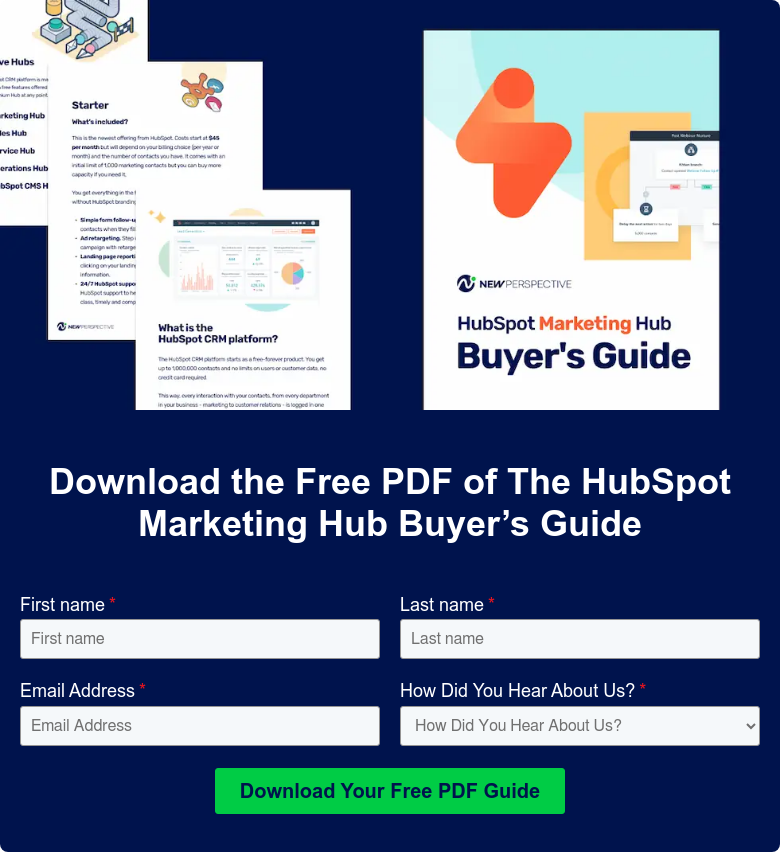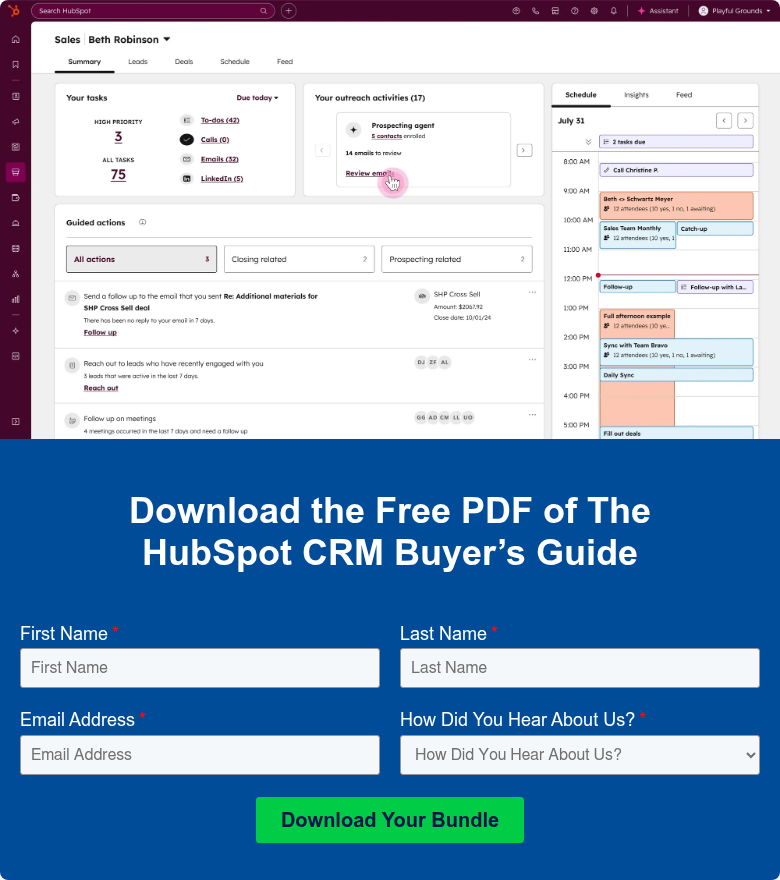Build These 5 Great HubSpot Workflows and Boost Marketing Success

If you’re a marketing pro, you’re likely on the lookout for tools and techniques to streamline your processes and make your marketing efforts count. Automated digital workflows are a modern must-have for helping your campaigns be more efficient and effective. If you haven’t yet tapped into the power of HubSpot, consider it now.
HubSpot is a powerful marketing automation platform that offers a whole range of customizable workflows to significantly boost the success of your campaigns. They save time and resources, deliver stellar results, and are surprisingly easy to build even if you’re new to the HubSpot system.
5 basic steps to the build HubSpot workflows
Make sure you have the necessary permissions in your HubSpot account to create and activate workflows. Then, for each HubSpot workflow, you’ll follow the same basic order to get it built and running:
1. Choose your audience
First, determine who you want this workflow to target. For instance: are you creating a workflow to bring in new leads, customers who haven’t made a purchase recently but have before, or existing customers you want to upsell? Segment your audience based on their behavior and interests to create personalized and relevant content.
2. Establish the workflow’s goals
What do you want this workflow to achieve? Choose the workflow according to your objectives and then set more specific goals for the actions within that workflow. For instance: if you’re creating a lead nurturing workflow, goals might include increasing engagement, converting leads into customers, or re-engaging inactive customers. The clearer the goal, the more you can create targeted content and the better you can measure the workflow’s effectiveness.
3. Create the content you’ll share with the audience
Most workflows involve reachout out to the audience with content, from emails to blog posts to social media messages. Whatever the form, your content should be engaging and relevant to your targeted audience, with strong calls-to-action that encourage them to take the next step.
4. Do the build using HubSpot’s menus
HubSpot makes this easy. The first thing you need is a HubSpot account to log into. We’ll walk you through how to create each workflow below.
5. Monitor, test, and optimize
We’ll get into this after we walk through each workflow, but here’s what you need to keep in mind: Workflows are adjustable and flexible so you can get the best out of them. Pay attention to their performance, test it out, and dig in to make it effective when you need to.
How to create each HubSpot workflow
Now let’s get into the 5 great workflows themselves. Once you’ve identified your audience, established your goals, and created the content you want your target to interact with, here’s how how to build each workflow:
1. Lead nurturing workflow
One of the most popular HubSpot workflows is lead nurturing. It helps you guide potential customers through the buyer's journey by sending targeted emails based on their actions and interests. It's a powerful way to convert leads into customers and ultimately grow your business with the help of inbound marketing.
To build your lead nurturing workflow in HubSpot:
- In your HubSpot account, click on automation, then select workflows from the dropdown menu.
- Create a new workflow and name it "Lead Nurturing Workflow."
- Select contact-based workflow and Start from scratch. HubSpot offers several types of workflows — contact-based, company-based, deal-based, ticket-based, and more — depending on your objectives. For lead nurturing (or qualification), a contact-based workflow is the best one to use.
- Add an enrollment trigger. These are the criteria that a contact must meet to enter your workflow. For instance, if a visitor lands on a particular page on your website, that may trigger their enrollment.
- Add a two-day delay post-enrollment. That will give the lead enough time to explore your website and learn more about your business. You don’t want to bombard your leads with emails right away.
- Add a condition requiring the lead to submit a form or survey. The form should ask for information that will help you better understand the lead's needs and preferences.
- Add the first email content. Offer a solution to the lead’s problem that demonstrates your expertise in the field but doesn’t get too far in the weeds.
- Add the second email content. Offer a more detailed solution to the problem with data and statistics, providing more in-depth information and demonstrating your knowledge.
- Add the third email content as a limited-time offer. Offer an incentive, such as a discount or free trial, to nudge the lead to make a purchase.
- Activate: Once satisfied with your workflow, you can activate it by clicking the turn on button.
2. Automated lead qualification workflow
Automating lead qualification is a game-changer that saves time and ensures your sales team is only interacting with the highest quality leads, focusing their marketing efforts.
A good lead qualification workflow should be dynamic and flexible, allowing you to adjust your criteria and actions as your understanding of your leads and their behavior evolves.
To build an automated lead qualification workflow in HubSpot:
- In your HubSpot account, click on automation, then select workflows from the dropdown menu.
- Select contact-based workflow and Start from scratch.
- Define an enrollment trigger. For a lead qualification workflow, you might include conditions such as the contact having a certain lead score, filling out a specific form, or visiting a certain page on your website.
- Set up your actions: Once a contact meets your starting conditions, what actions do you want them to take? Actions might include emailing, assigning a task to a sales rep, or updating a contact's property value. For example, for a lead qualification workflow, you might set up actions like sending a series of nurturing emails, assigning the contact to a sales rep if they reach a certain lead score, or updating the contact's lifecycle stage to marketing qualified lead (MQL) if they meet certain criteria.
- Review and test: Before you activate your workflow, it's important to thoroughly review and test it to ensure it's functioning as expected. You can test your workflow by enrolling a test contact and checking to see if the expected actions occur.
- Activate: Satisfied with your workflow? Time to activate it by clicking the turn on button.

3. Lead scoring and segmentation workflow
One of our favorite HubSpot workflows is lead scoring and segmentation. This lets you prioritize leads based on their engagement and interaction with your content, ensuring you target the right prospects. Keep your CRM data clean and maintain regular CRM data hygiene practices.
For this workflow, first you set up a lead scoring system. Then you create a segmentation workflow based on the scores.
You may need to adjust these steps to fit your particular sales process and customer journey — or HubSpot updates and what options you have per your account. (Check HubSpot's official documentation or contact their support if you encounter any issues.)
Make sure you also continuously monitor and adjust your lead scoring criteria and segmentation workflow as you gather more data about your leads and their behavior.
To build an lead scoring workflow and a segmentation workflow in HubSpot:
Set up lead scoring:
- In your HubSpot account, in settings, navigate to properties. You’ll find the settings icon in the top right corner of the screen. Use the left sidebar menu to navigate to properties. In the search properties box, type in “HubSpot score“ (if you signed up for HubSpot pre-2015, type in “lead score”) and select it from the dropdown menu.
- Create a new scoring rule: Click on create scoring property, then, in the panel on the right, click add set of criteria.
- Define your scoring criteria: What actions or characteristics should increase or decrease a contact's lead score? For instance, visiting a certain page on your website might add points. Not opening an email might deduct points. For each, assign a positive or negative score and how much it affects a contact's total score. Repeat this process for all relevant behaviors and characteristics. Don’t forget to click save when you’re done.
Create a segmentation workflow based on lead score:
- In your HubSpot account, click on automation, then select workflows from the dropdown menu.
- Select create a new workflow. We recommend choosing a contact-based workflow and starting from scratch for lead segmentation.
- Define enrollment triggers: For this purpose, the trigger should be based on when a contact's lead score reaches a certain threshold.
- Set up actions. For a lead segmentation workflow, you might set up actions like sending an email, updating a contact's lifecycle stage, or assigning the contact to a sales rep.
- Review and test. Devise a test contact to see how it’s working.
- Activate: If you’re all set with the workflow, activate it with the turn on button.
4. Customer onboarding workflow
A smooth onboarding process is crucial for customer satisfaction and retention. HubSpot enables you to create an automated onboarding workflow that guides new customers through a series of helpful resources so they can get the most out of your product or service.
To build a customer onboarding workflow in HubSpot:
- In your HubSpot account, click on automation, then select workflows from the dropdown menu.
- Create a new workflow and name it “Customer Onboarding Workflow."
- Select contact-based workflow and start from scratch to build it from scratch.
- Add the enrollment trigger on the customer sign-up form as a form submission. Whenever a new customer signs up, this will trigger the workflow.
- Add a delay of one day after enrollment — to give the new customer time to explore your product or service before receiving the first email.
- Add the first email content. Make it a personalized welcome and introduction to the product or service that explains why it's better than any other solution out there and makes customers feel valued and excited about using it.
- Add the second email content. This one should be more informative, explaining the product or service’s essential features, and providing a step-by-step guide on how to use it.
- Add the third email content (optional). Make this email a call-to-action that encourages the customer to provide feedback and suggestions for what to improve. This approach can help retain the customer.
- Activate with the turn on button.
5. Re-engage cold leads workflow
Re-engagement workflows are crucial for reaching those cold leads that fell out of the sales funnel and reigniting their interest. Sending targeted content and offers can remind them of your brand's value and encourage them to re-engage — increasing your sales opportunities and maximizing the ROI on your initial lead generation efforts.
You don’t want to come across as too aggressive or spammy, though. Opt for a gentle, value-first approach, and provide an easy way for leads to opt out if they're no longer interested.
To build a workflow to re-engage cold leads in HubSpot:
- In your HubSpot account, click on automation, then select workflows from the dropdown menu.
- Click on create workflow. Select contact-based as the workflow type, since you will be engaging with individual leads.
- Create the enrollment triggers. In this case, set triggers based on the last contact date, email engagement, etc., to identify cold leads. For instance, you might choose leads that haven't interacted with your company in the last six months.
- Choose your actions. Once the contact is enrolled, what happens next? In this case, you may want to send a series of emails to re-engage the cold leads. For example, your first action might be to "Send an email" using an email template you created.
- Set up your workflow settings. For example, you can set the time zone for executing the workflow actions and specify other settings per your requirement.
- Review your workflow. Before activating the workflow, test it out to ensure everything is running smoothly.
- Activate: Activate with the turn on button.

Back to that final step: Monitor, test and optimize
Marketing automation is a continuous process. Don’t treat it like a one-and-done. Once you activate a workflow, watch its performance, including key metrics like open rates, click-through rates, and conversion rates.
Use this data to identify areas for improvement and optimize for better results. Keep monitoring to make sure they’re delivering value, and don’t be afraid to tweak and adjust. These workflows are meant to support your marketing campaign and drive the results you need. Make them work for you.
What about ChatSpot?
If you’re already comfortable using AI to help you achieve your content generation goals, HubSpot’s got its own AI tool for marketing automation: ChatSpot. This conversational CRM bot can help with reporting and status questions, reaching out to contacts and leads, performing prospecting research, and doing sales forecasting using your HubSpot data. We expect further iterations will make it even more useful, likely by the time you read this article.
The goals: Better connections, more leads, more conversions
There are countless benefits to using HubSpot workflows. Marketing automation is a vital part of modern lead nurturing and boosting conversions. Make sure you know your audience, know how to best build the workflows that target them and offer engaging, personalized experiences, and get comfortable with the ongoing monitoring, analysis and optimization that’s going to make them effective.
We’re HubSpot experts who know how to get the best out of this juggernaut of a platform. If you want to learn more about harnessing HubSpot’s workflows for true growth, we’d be happy to walk you through it. Reach out and schedule a free consultation.
Note: We’re testing out the capabilities of AI for our clients using ourselves as guinea pigs. For this post we knew what we wanted to say — we’re longtime experts in HubSpot — but we pushed an LLM AI tool to see what it came up with. What you’ve just read is conceived by our team, partially generated by AI, then (very) substantially edited and revised by us.




